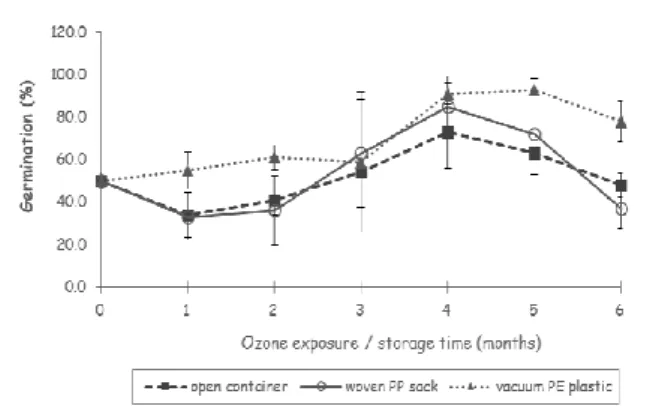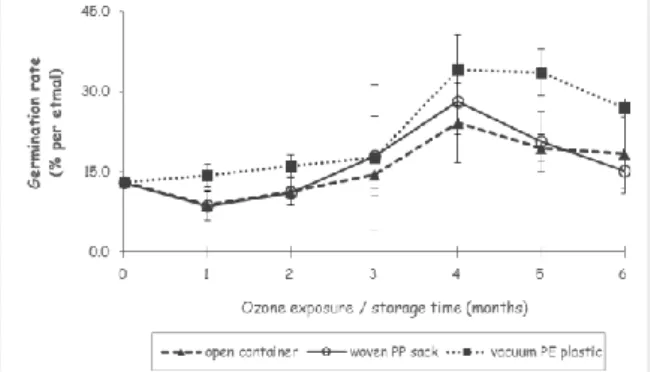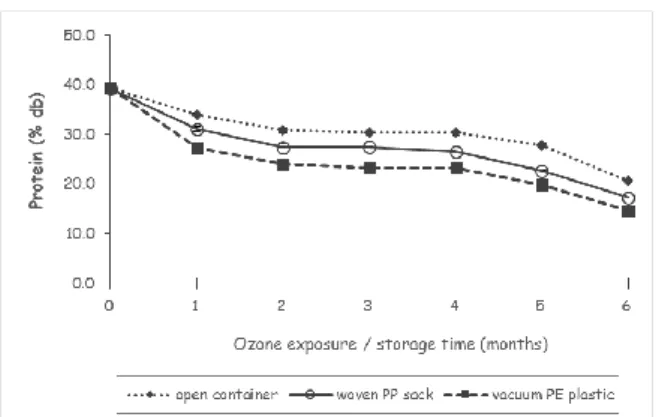西 南 交 通 大 学 学 报
第 56 卷 第 2 期
2021 年 4 月
JOURNAL OF SOUTHWEST JIAOTONG UNIVERSITY
Vol. 56 No. 2
Apr. 2021
ISSN: 0258-2724 DOI:10.35741/issn.0258-2724.56.2.14
Research article
Environmental Sciences
T
HE
E
FFECTS OF
O
ZONE
E
XPOSURE ON
A
GED
S
OYBEAN
S
EEDS
S
TORED IN
D
IFFERENT
P
ACKAGING
臭氧暴露对不同包装保鲜的老化大豆种子的影响
Indrie Ambarsari a, *, Intan Gilang Cempaka a, Sigit Budi Santoso b, Munir Eti Wulanjari a, Muhammad Nur c
a Central Java Assessment Institute for Agricultural Technology
Jl. Soekarno-Hatta Km. 26 No.10, Bergas, Kabupaten Semarang, Indonesia, indriе.аmb@gmail.com
b Indonesian Cereal Research Institute
Jl. Dr.Ratulangi No. 274, Allepolea, Maros, Sulawesi Selatan, Indonesia
c Physics Department, Faculty of Science and Mathematics, Diponegoro University
Jl. Prof. Soedarto No. 50275, Tembalang, Semarang, Indonesia
Received: January 12, 2021 ▪ Review: February 26, 2021 ▪ Accepted: April 10, 2021 ▪ Published: April 30, 2021
This article is an open-access article distributed under the terms and conditions of the Creative Commons Attribution License (http://creativecommons.org/licenses/by/4.0)
Abstract
This article describes an idea about improving the aged soybean seed quality through ozone application based on the consideration that the ozone's oxidative and reactive nature could preserve agriculture commodities during storage. Using soybean seeds that were naturally aged in room temperature storage (25±5°C) for two months, gaseous ozone's efficacy in rejuvenating the aged seeds was examined. The aged seeds were divided into three different packages: open container, polypropylene woven sack, and vacuum polyethylene plastic. Gaseous ozone at a capacity of 150 g/h was continuously exposed on packaged seeds during six months of storage under low temperature (18±5°C). The authors found that ozone in specific limit exposure could improve physiological characteristics and inhibit some chemical properties deterioration of aged soybean seeds during storage. Our technique allows for improvement in germination percentage and germination rate of aged seeds in the fourth month of ozone exposure (p<0.05). However, these physiological parameters decreased significantly in the sixth month of ozone exposure, signing that prolonged ozone exposure would lead to adverse effects due to excessive oxidation. The result also showed that ozone storage significantly retard the elevation of moisture and free fatty acid content of aged soybean seeds. The ozone effectiveness evaluation is confirmed in all packaging conditions, but the vacuum packaging offered better preservation on almost entirely seed quality parameters during storage, except for protein. This research result provides a promising technique to restore aged seed quality and can be used for better seed provision in the seed industry.
摘要 本文考虑到臭氧的氧化和反应性质可以在存储过程中保护农业商品,因此提出了通过应用臭 氧来改善老化大豆种子质量的想法。使用在室温存储(25±5 摄氏)中自然老化两个月的大豆种 子,研究了气态臭氧使老化种子恢复活力的功效。老化的种子分为三个不同的包装:开放容器, 聚丙烯编织袋和真空聚乙烯塑料。在低温(18±5 摄氏)下储存六个月期间,以 150 克/小时的容 量将气态臭氧连续暴露在包装的种子上。作者发现,特定限度暴露的臭氧可以改善老化特性,并 抑制老化大豆种子在存储过程中某些化学性质的恶化。我们的技术可以提高臭氧暴露第四个月中 老化种子的发芽率和发芽率(p <0.05)。但是,这些生理参数在臭氧暴露的第六个月显着降低, 这表明长时间的臭氧暴露会由于过度氧化而导致不利影响。结果还表明,臭氧存储显着延迟了老 化大豆种子的水分和游离脂肪酸含量的升高。在所有包装条件下都可以确认臭氧有效性评估,但 是真空包装可以在存储过程中对几乎所有种子质量参数(蛋白质除外)提供更好的保存。该研究 结果为恢复老化种子的质量提供了一种有前途的技术,可用于种子工业中更好的种子供应。 关键词: 老化种子,臭氧,包装,大豆
I. I
NTRODUCTIONSoybean (Glycine max L.) is one of the world's most valuable foods and oilseed crops. This commodity is widely known as an essential and excellent source of various macro/micro-nutrients and bioactive compounds, hence draw much attention due to its health benefit in preventing and lowering the risks of several chronic diseases [1], [2]. Global soybean demand is projected to continue enhancing in the forthcoming years due to the growing consumption of soy-based health products. In this regard, seed production is a fundamental part of plant propagation that plays a prominent role in commercial soybean-based industries.
However, seed aging becomes a considerable constraint in soybean and other agricultural production. Its occurrence causes delayed germination, reduced vigor, and viability deprivation, leading to genetic and financial losses [3], [4]. This process could occur even under optimal storage conditions [5]. Numerous attempts have been developed to rejuvenate the aged seed quality. Most researchers used nanoparticles to improve the aged seeds characteristic [6], [7]. Unfortunately, this method has raised safety issues concerning its potential toxicity that could endanger human health and the whole environmental system [8], [9].
Ozone has known as a promising postharvest method for preventing stored seeds from damage, which has avowed as safe and environmentally friendly because it decomposes quickly into oxygen in the air without residues [10]. The oxidation power and highly reactive nature of ozone effectively controlled insect development [11] and reduced fungal presence on stored seeds without affecting their physiological properties [12]. Ozone was also proven able to degrade
pesticide residues on seeds [13]. However, in some cases, ozone treatment could also lead to undesirable impacts, contribute to oxidative degradation in physicochemical and sensory properties [14], [15]. The efficacious ozone on seeds could be diverse depending on factors such as ozone concentration, frequency, exposure time, the kind of seeds, and its grain integrity [16].
Several reports confirmed that ozone treatment has greater efficacy when integrated with refrigerated storage and appropriate packaging [17], [18], [19]. As an essential part of preservation, it is plausible that proper packaging has a prominent contribution in preserving seed viability until the seeds required for the subsequent sowing season. Hence, the combination of ozone with packaging technology is expected could optimize the aged seed rejuvenation without negative impacts.
To the best of our knowledge, there is little literature about the combination effects of ozone and packaging treatment on improving seed quality, especially on soybean seeds. Moreover, there is no report available on the ozone effects in rejuvenating aged seeds. Thus, this study is intended to assess the effects of ozone exposure and packaging treatments on aged soybean seed properties during storage. The evaluation on this topic is crucial, considering that ozone could be an alternative method for improving the aged seed quality. Simultaneously, packaging treatment could help optimize the ozone power in extending the aged seed shelf-life. Since the rejuvenation mechanism generally involves a series of changes on aged seeds, this ozone evaluation focuses not only on the physiological properties but also on the chemical composition changes. We expect that the information obtained
would be valuable to the seed industries for better seed provision.
II. M
ETHODSFreshly harvested soybean seeds (cv. Grobogan) were obtained from seed producers in Grobogan, Central Java-Indonesia. Before the experiment, soybean seeds were kept under conventional storage at room temperature (25±5 °C) for two months to attain natural aging conditions.
Afterward, the aged seeds were preliminary exposed to gaseous ozone at a capacity of 150 g/h for three hours. Seed samples were spread out on the floor using a plastic mat to ensure homogenous contact between seeds and ozone. Ozone was applied from an ozone generator (DIPO Technology, Semarang, Indonesia) equipped with a device to adjust the concentration and exposure time.
Subsequently, the seeds were divided into three different packagings: open containers (perforated plastic basket), polypropylene (PP) woven sacks, and vacuum polyethylene (PE) plastics. Each treatment in the experiment was laid out in three replications, respectively. Seeds in PP woven sacks were sealed using a portable stitching machine, while seeds in PE plastics were heat-sealed using a vacuum packaging machine DZ-400/2E (Hualian, China). After packaged, the whole seed samples were kept under low temperature (18±5 °C) and continuously exposed to ozone at a capacity of 150 g/h for three hours a day. Disposable masks and gloves must be used throughout the ozone experiment as a precaution.
Analysis of aged seeds quality during ozone storage consisted of physiological and chemical properties. The physiological analysis included germination percentage and germination rate were performed based on International Rules for Seed Testing [20]. Meanwhile, the chemical analysis consisted of the gravimetric method for moisture content [21], the Kjeldahl method for protein content [21], and the American Oil Chemists Society standard method for free fatty acids (FFA) content [22]. Data was collected repeatedly at a monthly interval (0, 1, 2, 3, 4, 5, and 6 months of storage).
The repeated-measurement ANOVA was submitted as the experimental data design [23]. The duration of ozone exposure was given as a within-subject factor, while the packaging treatment was given as a between-subject factor. The analysis was performed using a Greenhouse-Geisser correction at the significance level of p<0.05. The difference between means was
determined using the Tukey test. SPSS 20.00 software (SPSS Inc., Chicago, IL, USA) was operated for statistical analysis.
III. R
ESULTS ANDD
ISCUSSIONA. Physiological Quality
Seed deterioration is a complex process associated with numerous physiological changes. In this study, the physiological effects of ozone exposure on aged soybean seeds are presented in the germination percentage and germination rate alteration during storage.
1) Germination Percentage
The effects of ozone exposure on germination percentages of aged soybean seeds stored in different packaging are shown in Figure 1. The germination ability drastically increases in the fourth month of ozone exposure (p<0.05), but then it decreases in the sixth month of ozone exposure (p<0.05). This finding is consistent with previous reports, which stated that ozone effects in germination ability were influenced by exposure time [16]. Some researchers explained that the ozone capability in improving germination is related to the seed's internal energy and antioxidant power activation [24], [25], [26]. Meanwhile, an excessive level of oxidative stress due to long-term ozone exposure would be lethal and destroy the seed cell [11], [25], [26]. An accumulation of free radicals from prolonged ozone exposure would hinder the formation of adenosine triphosphate (ATP) and intermediates necessary for cellular biosynthesis and seed germination, thus reducing the germination percentage.
Among all packaging treatments, vacuum packaging offers the most appropriate environment for maintaining seed germination during ozone storage (p<0.05). Probably the low permeability of vacuum PE plastics retarded the water uptake during imbibition and thus prevent the seeds from severe germination losses [27].
Figure 1. Ozone exposure effect on germination percentage of aged soybean seeds stored in different packaging
2) Germination Rate
Figure 2 shows the effects of ozone exposure on the germination rate of aged soybean seeds stored in different packaging. The germination rate of aged seeds in all packaging significantly increases in the fourth month of ozone exposure (p<0.05). However, it significantly decreases in the sixth month of ozone exposure (p<0.05). This output is similar to the previous research on corn seeds, which declared that short-term ozone exposure resulted in a higher germination rate than long-term ozone exposure [26]. Another report also confirms the phenomenon that restricted ozone could be a seed germination rate enhancer, while excess ozone induces adverse impacts [28].
The highest germination rate was recorded in vacuum packaged seeds (p<0.05). It is assumed that vacuum nature could retard respiration rate by preventing water transmission and gas exchanges during storage, hence optimizing the ozone performance in enhancing germination rate.
Figure 2. Ozone exposure effect on the germination rate of aged soybean seeds stored in different packaging B. Chemical Properties
The evaluation of chemical characteristics is essential since the chemical composition of seeds influences seed viability and longevity. The effects of ozone exposure on the chemical properties of aged soybean seeds in this current study are represented in the moisture, protein, and free fatty acid content.
1) Moisture Content
Seed moisture is an essential factor affecting seed quality, as seed shelf-life depends on its moisture contents [29]. The effects of ozone exposure and packaging treatments on the moisture content of aged soybean are shown in Figure 3. The moisture content of aged seeds in all packaging treatments significantly reduces with the more extended ozone exposure time (p<0.05), and the lowest moisture content is found in open packaged seeds (p<0.05). The initial moisture content of aged seeds was about 11.5%. At the end of storage (sixth month of ozone exposure), the seed moisture reached 8.6,
10.1, and 10.8% for open packaged, PP sack, and vacuum packaged, respectively.
This present result contrasts with previous findings, which reported that ozone treatment has no significant impact on the grains' moisture content [18], [30]. Other research also declared that moisture content reduction on ozonized samples is more affected by low relative humidity during storage [31].
The main explanation for high moisture losses in open packaged seeds is that there is a water movement from samples to the surrounding atmosphere, resulted in low moisture content on the seed samples. Meanwhile, the vacuum packaging capability on suppressing moisture losses might be attributed to the plastic film barrier properties and low oxygen level in the vacuum-seal packaged.
Figure 3. Ozone exposure effect on the moisture content of aged soybean seeds stored in different packaging 2) Protein Content
Figure 4 shows the effects of ozone exposure on the protein content of aged soybean seeds stored in different packaging. As more extended ozone exposure time, the protein content of aged soybean seeds significantly decreases (p<0.05). This finding is similar to the former study in peanut seeds [15] and chickpea grains [32], which indicated that the oxidation properties of ozone could induce the alteration of polypeptide chains in viral protein coats resulted in protein degradation [17], [33]. Other investigations also noticed that free radicals' generation due to ozone exposure brings the seed cellular damage and amino acids oxidation, implicated in protein reduction [4], [34].
This present study also reveals that vacuum packaged seeds had the lowest protein content, while open packaged seeds had the highest protein content (p<0.05). It is not clear why vacuum packaging's barrier properties failed to inhibit protein losses during ozone exposure. Nonetheless, a study in cheese demonstrated that low oxygen level in vacuum packaged samples is inadequate to prevent protein oxidation [35].
Figure 4. Ozone exposure effect on the protein content of aged soybean seeds stored in different packaging 3) Free Fatty Acids
Figure 5 shows that the FFA of aged seeds in all packaging treatments reduced significantly along with the prolonged ozone exposure (p<0.05). There is a possibility that the decrease of FFA associates with the ozone capability in reducing micro-organism contamination in the stored grains [18], [36]. Another report presumed that low moisture content and proper packaging play an important role in obstructing lipid oxidation during the ozonation process, thus lowering the FFA [18].
The lowest FFA content of aged soybean seeds during ozone exposure was recorded in vacuum packaged seeds (p<0.05). This result indicates that vacuum condition is sufficient to obstruct an oxidative reaction such as lipid oxidation during ozone exposure. Some researchers also suggested using vacuum packaging during grain storage to inhibit the FFA value increase, thus retarding the rancidity development [37].
Figure 5. Ozone exposure effect on FFA content of aged soybean seeds stored in different packaging
IV. C
ONCLUSIONThis work found that ozone in a specific limit exposure significantly improves aged soybean seed physiological attributes. Ozone is also potent in retarding the aged seeds' chemical changes, such as moisture content and free fatty acids. Moreover, a combination of ozone with vacuum packaging provides better preservation
properties for inhibiting aged seed deterioration during storage.
Principally, it can be concluded that ozone could become a promising advancement technique to solve the aged seed quality in agriculture production. This technique offers a tremendous advantage to rejuvenate aged seed quality, extend seed longevity, support high-quality seed provision, and enhance crop production in seed industries.
A
CKNOWLEDGMENTThe Indonesian Agency for Agricultural Research and Development through the Assessment Institute of Agricultural Technology Central Java funded this research project. Our team also wishes to thank DIPO Technology, Ltd. and the Agriculture Office of Grobogan District for the ozone generator and proponent facilities at the Soybean Seed Center, respectively. Last but not least, we grateful to Dr. S. Prawirodigdo for helpful advice during our manuscript preparation.


